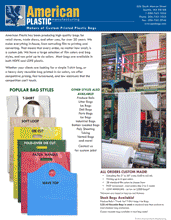What are overruns and underruns?
Overruns and underruns are an unavoidable part of the manufacturing process. It's tempting to look at it similarly to printing copies on your desktop printer. If you need 200 copies, you print 200 copies. Manufacturing bags isn't quite as simple, and adds several unpredictable factors.
There are three main steps, and machines, in making most bags.
- Extruding the film - resin pellets and color concentrate are mixed, melted and blown into a long tube that is then wound on a roll
- Printing the film - the roll of extruded film is transferred to a printing press, printed, and again wound on a roll.
- Converting printed film into bags - printed film is transferred to a converting machine to be cut and sealed into individual bags.
All three steps require extra material in order to setup. If setup on all three processes goes quickly and easily, we end up with overruns. And a challenging setup that takes longer and requires more material results in underruns.
For example, to convert 20,000 bags, we need to have enough printed film to convert that number of bags, plus extra to set up the machine properly to cut and seal in the correct position. So quite a few more than 20,000 impressions need to be printed. To make sure we have enough film to print the ordered quantity of bags plus extra for converting setup, we have to extrude more than enough film to set up the printing press - and each print color is set up and registered individually, so more colors mean more setup and more waste. Extruding enough film requires mixing resin pellets with color concentrate, melting the mix and blowing into a long tube that is then rolled up. Extra resin is needed at this stage to adjust the size and thickness of the film as it goes through the extruder, and small variances in width and thickness of film during extrusion can also affect overruns.
All of these steps create a unpredictable amount of waste when setting up. We do our best to estimate raw material use accurately, but ending up with an exact number of bags is nearly impossible, and the over/under percentage is not predictable.
The percentage of overruns and underruns is higher with small orders, and generally much lower with larger orders, as the setup process is the same on every order.
More information about our overrun policy is on our terms and conditions page. https://www.apmbags.com/terms-and-conditions


